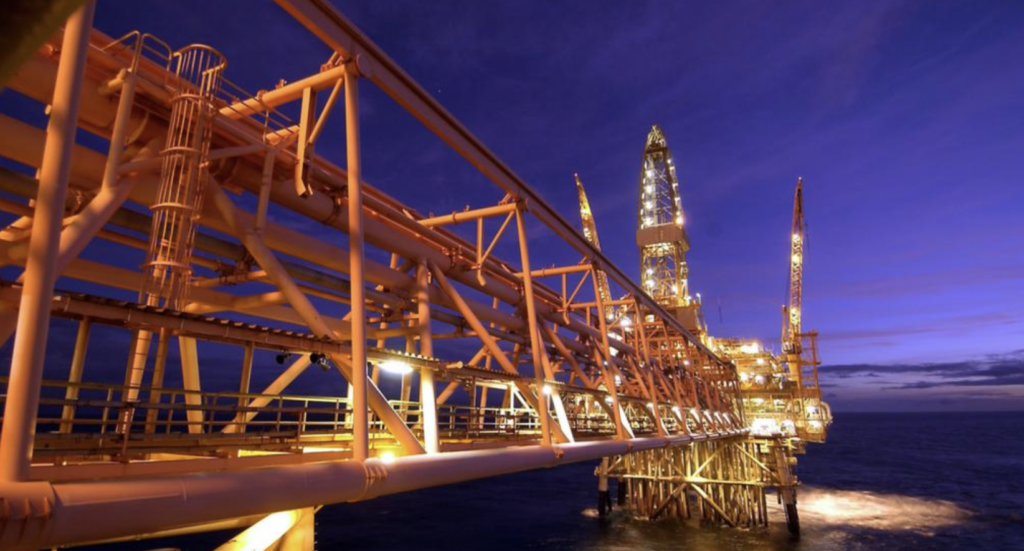

Commentary by Richard Court courtesy of the West Australian.
Woodside’s North Rankin A platform, part of the North West Shelf project.
I can sense panic is starting to set in behind the scenes in the Federal and the east coast State governments on the energy front.
On one hand they have so successfully demonised fossil fuels and created unrealistic expectations on the time lines for the transition to large-scale renewable sources. But on the other hand they are loving the massive growth of revenues flowing into their treasuries from the very same fossil fuels both during and after the COVID lockdown years.
The world is demanding more, not less, electricity but people want it generated and distributed in a more environmentally friendly way.
Domestically, this challenge is proving relatively easy for homeowners in Australia with rooftop solar but for heavy industry and other large electricity users including hospitals, universities and retail outlets it is more challenging. The transition is not working out as presented to the Australian public and, belatedly, governments are now realising gas will continue to play an important support role for decades to come.
Energy costs are soaring, electricity and gas shortages are looming at the same time as renewable projects navigate the approvals obstacle course which State and Federal governments mandate. On top of this situation they have created uncertainty with our long-term export customers and extra hurdles making new investments more challenging.
It has taken more than 40 years to build up the strong trust and respect that we have with energy customers and energy investors, so it is disturbing that the threat of serious sovereign risk has now been introduced into the energy debate in the first 12 months of the Albanese Government. The ramifications of this will have serious long-term consequences.
Highly embarrassed governments are offering “energy price relief” in different forms to domestic users to try to relieve cost-of-living pressures, and, often under union pressure, subsidies to secured industries so they are not forced to close their doors.
What industries are to be protected? It would appear that Victoria cannot even produce a humble brick without providing energy subsidies.
Who is to blame? It has been a great team effort to achieve energy incompetence on the east coast of Australia.
All the key players are at fault — the major political parties, the coal, gas and renewables sectors, State and Federal governments and the key energy corporates who have not shown proper leadership to see we have an orderly transition.
The story goes like this.
Coal was the dominating energy provider for nearly two centuries. During that time if you dared to criticise the coal industry the Labor Party would come down on you like a ton of bricks. When gas was first discovered in Western Australia it was seen as the enemy of coal.
As environmental awareness grew, coal was then put in the dirty corner and a rearguard reaction by the coal industry said that with a new generation of HELE (high efficiency low emissions) it would significantly lower emissions but the industry did not follow through with the investment required to replace the old, large coal-fired stations.
The gas industry decided to kick the coal industry saying “we are much cleaner and we will be the transition fuel to more renewables”. The only problem is that when it was needed, it was not there on the east coast. Why?
This is where incompetent State and Federal governments step in. Three LNG plants were approved at Gladstone without any domestic gas reservations put in place. At the same time there was continuing criticism of WA’s domestic gas reserves policies by the resource ministers from both Labor and Coalition sides and the industry itself — talk about being asleep at the wheel.
WA’s policy was legislatively put in place in 1979 for the North West Shelf Project and all WA State governments since then have continued this policy.
I sat through decades of respective Coalition and Labor Federal government resources ministers criticising the West Australian policy at the annual APPEA conferences, cheered on by the corporate gas heavyweights.
The Government’s climate change legislation is designed to reduce Australia’s emissions targets to net zero by 2050. It also wants to have renewable energy providing 82 per cent of the main electricity grid by 2030. We have the Federal Government spruiking the need to move further down the value-adding path with our abundant resources including further processing of gas to the nickel, lithium, bauxite, rare earths, etc. All of this is well overdue but all these processes are very energy intensive.
We need to have respected engineers explaining to the Australian public the practical challenges of the transition to renewables and the scale of energy required for further value adding. If we do not go down the value-adding path we will continue to export raw materials and see value adding offshore, often involving higher emission levels. We should always remember that with primary production we remain price takers and not price setters, leaving us very vulnerable to movements in commodity prices.
When it comes to the resources sector, Federal governments have not exactly distinguished themselves. On the taxation front they came up with a poorly designed PRRT taxation requirement for royalties in the oil and gas sector. It was a great theoretical proposals pushed by economic policy wonks in Canberra to late resources minister Peter Walsh and prime minister Bob Hawke back in 1987. Poorly designed to cover massive growth in LNG production and, although modified over the years, it is a dud.
As a State treasurer for eight years, give me an assured royalty stream from day one any day — you only have to examine the performance of iron ore royalties. It was also a mistake by FIRB, and the Howard government, to approve the sale of the last remaining Australian reserves in the Gorgon gas fields, one-seventh owned by Ampolex — a Peter Costello decision.
As a State government we would have warehoused that interest until another Australian equity partner was found due to the massive scale of these gas reserves. The WA government was not advised of this process. Fortunately, the Federal government saw the light of day with the Shell proposal to take over Woodside.
Similarly, when the NSW and Victorian governments decided not to develop their onshore gas production it would have made sense more than a decade ago to show leadership in developing a west-to-east gas pipeline to ensure security.
It is ironic the way both our Government and the US Government under President Joe Biden were elected with strong climate change commitments, but are now pleading for oil and gas production to be expanded to lower energy costs — am I missing something?
The way forward needs to be driven by realistic energy expertise, realistic time frames and realistic assessments of the costs of renewable options and the backup capacity that is required. The renewables journey will require a massive increase of skilled tradespeople across the country remembering they need to complete a four-year apprenticeship before gaining some years of experience.
We must be realistic on the procurement front with the great majority of the solar and wind equipment currently being provided by China or some other specialist suppliers in Europe who are already fully stretched.
Governments are glibly announcing large-scale renewable projects onshore, offshore, etc without fully appreciating the extensive mandated approvals processes and on top of that the local communities’ social licence to proceed. This social licence issue has become a huge issue in Europe and the US and already we are seeing it with the local communities’ backlash to some of the interconnector transmission lines being proposed.
It will also be essential for the gas and electricity sectors to be better co-ordinated. The public will demand a resilient electricity grid. If we become over-dependent on electricity alone, the lack of energy sources will be problematic.
Ironically, I would not be surprised if the most effective large-scale wind and solar investments are by the mining and gas companies in the Pilbara significantly cutting emissions in their massive export earning operations.
They have the financial muscle, the construction experience and operational expertise in a region ideally suited to wind and solar.
As we know LNG plants, in simplistic terms, are a large refrigerator with a large power station attached to it and LNG produced with high levels of renewable electricity makes it a more attractive product.
Similarly new carbon capture and storage projects need to be supported by State and Federal governments as obstacles are already in the way to accessing suitable geological structures.
I would not be surprised if South Australia, with its abundant uranium resources and its need to build up significant nuclear energy expertise with the submarine contracts, builds a nuclear power station to supply Victoria and New South Wales the clean energy their inner-suburban elite craves.
In summary, I am surprised that the unions and industry have not combined on energy policy to demand a more orderly transition on this journey to renewables.
Subsidies only work in the short term and lead to long-term inefficiencies.
Richard Court is a former WA premier and ambassador to Japan.




